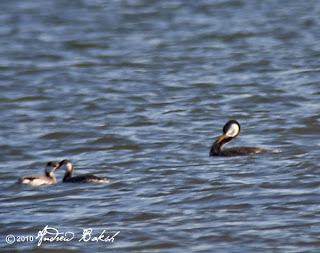 The flags at Fire Island gives an idea of how windy it was that day.
The flags at Fire Island gives an idea of how windy it was that day.Following the
Southern Nassau County Christmas Bird Count, I returned the next day, January 3rd, to Long Island for more punishment…er, I meant the
Captree Christmas Bird Count. I found out that this was the 48th year for the count since its inception in 1962. The weather was worse than the previous day. On the beach, the wind gusts were averaging well over 26 mph, maxing out at probably around 45-48 mph. I met Patricia Lindsay and Shai Mitra around 7:15 a.m. and after picking up our permits required to access the fields that were closed, we began our day by birding
Fire Island at
Robert Moses State Park. Our first objective was a sea watch. When we got to our first sea watch location, the wind was blowing so hard that we had to hold on to the doors of our vehicles as we opened them for fear they would get ripped off. Pat unfortunately had her scope blown over in the parking lot; thankfully, only the body was a bit bruised and the glass remained intact with no damage.
 Shai and Pat trying to stay out of the wind during a sea watch.
Shai and Pat trying to stay out of the wind during a sea watch.We found a spot that offered some shelter out of the wind and did our sea watch, picking up several species including all three
Scoters,
Gannets,
Loons and lots of
Long Tailed Ducks. Surprisingly, we did not get a
Common Eider during that watch. Then it was time to split up; I was supposed to bird
Democrat Point with Shai. However, after the boat stint during the
Southern Nassau County Christmas Bird Count, Pat was not having any of it. She insisted that I bird with her away from the water and wind indicating that I had paid my dues the day before
(see my post on Southern Nassau County Christmas Bird Count)and Shai too agreed with her. It was two against one and so I acquiesced, knowing they meant well.
 American Pipit
American Pipit.
It was settled that, Pat and I were going to bird
Connetquot State Park, while Shai was going to
Democratic Point and then continue to bird
Fire Island. On our way out of
Fire Island, Pat and I birded the median around fields 2-6 and found a few birds for our list; the best sighting and quite the surprise were around
26 American Pipits. We also picked up our first
Common Eider of the day when we stopped at one of the fields to do a quick sea watch.
 Tom Burke and Gail Benson helping out at Connetquot State Park.
Tom Burke and Gail Benson helping out at Connetquot State Park.
Over at
Connetquot State Park, we were joined by Tom Burke and Gail Benson. Tom was not feeling too well, but was sticking it out. Such is the dedication of these hardy birders. After scoping out and documenting the species on the pond, Pat and I worked the trails adding a number of species to our list. Our best find was a
Pine Warbler, which might have been a save for the count. We also had a
Tundra Swan, which I believe was the only one for the count. After several hours at
Connetquot State Park, we joined Shai for a short lunch break where we reviewed our numbers and planned our strategy for the rest of the day. After lunch, Pat and I continued to hit spots that were on our assigned route and checked in with other teams to see if they needed help. We learned that teams working the beach fronts were having a torrid time, with heavy wind and swirling sand. Around 3:30 p.m. we rejoined Shai at
Fire Island for a final sea watch; we were hoping for a
Razorbill, which had eluded us for the day. Alas, the
Razorbill was not to be and after about 45 minutes we called it a day.
 A few of the intrepid birders enjoy dinner after a long day in the field.
A few of the intrepid birders enjoy dinner after a long day in the field.
Dinner and compilation was held at
Villa Monaco in West Islip. The dinner crowd was not as large as the one for
Southern Nassau County, but we had a decent turnout. Our compilation went well and it turned out
109 species were recorded (plus one additional distinctive subspecies), a total well below the count’s 20-year average of 116 species. However, given the weather conditions, everyone present felt the results were quite impressive. It was another tough day for birding, but I thoroughly enjoyed every bit of being out with a great bunch of people all contributing to
citizen science.
Source Shai Mitra Highlights included:
7 Greater White-fronted Geese at Belmont1 Cackling Goose at Belmont1 Tundra Swan at Connetquot8 Wood Ducks at Belmont1 Eurasian Wigeon in the Babylon-West Islip area3 Common Eider on the ocean front116 Common Mergansers, obliterating the previous max of 22, from 1995 (a consequence of rescheduling the count two weeks later)2 Virginia Rails in the West Sayville area1 Killdeer in Bay Shore1 Iceland Gull in the Babylon-West Islip area1 Lesser Black-backed Gull in Bay Shore1 Great Horned Owl by the North party12 Tree Swallows in the Oak Beach-Cedar Beach area29 American Pipits1 Pine Warbler at Connetquot2 Chipping Sparrows at Heckscher











































